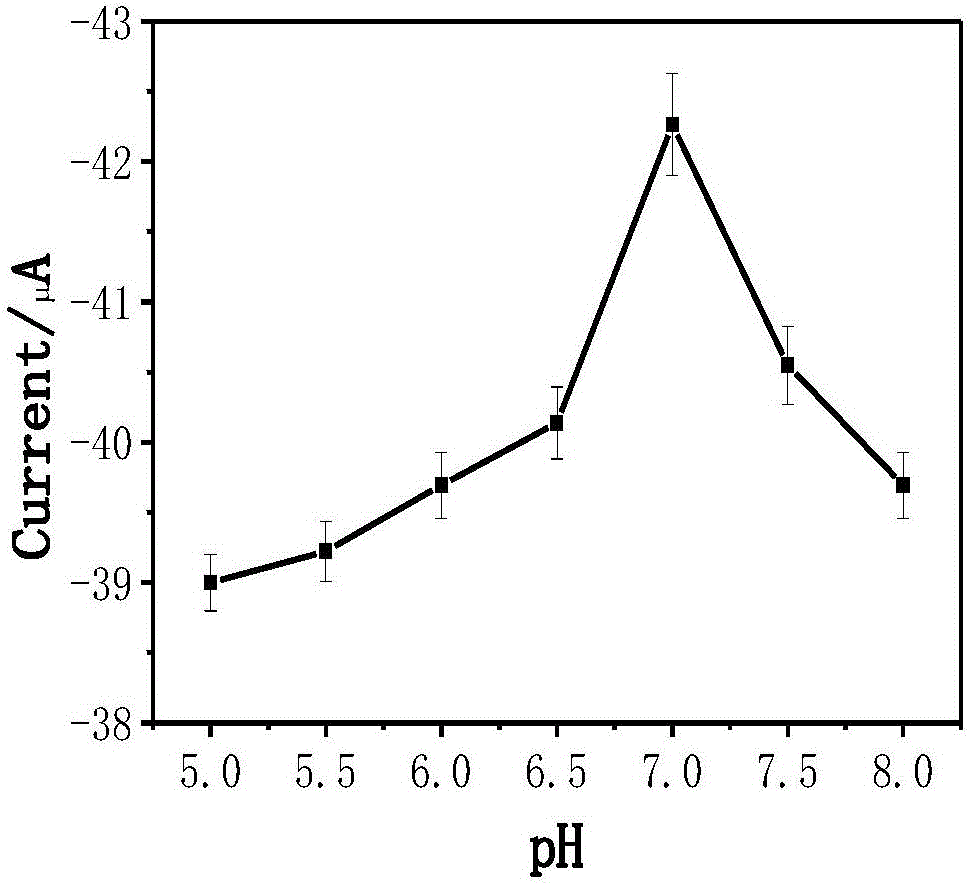Preparation method and detection method of carcino-embryonic antigen electrochemical immunosensor
An immunosensor and carcinoembryonic antigen technology, applied in the field of immunosensors, can solve the problems of unstable electrochemical response, complex detection steps, wrong detection results, etc., to eliminate the interference of dissolved oxygen, high selective permeability, and low cost. Effect
- Summary
- Abstract
- Description
- Claims
- Application Information
AI Technical Summary
Problems solved by technology
Method used
Image
Examples
Embodiment 1
[0037] 1. Preparation of poly-o-phenylenediamine nanospheres (POPD)
[0038] Add 200μL of 0.1M o-phenylenediamine to 3mL of water, inject 30ml / min of ozone into the solution and keep stirring. After stirring for 5h at room temperature, centrifuge the reaction product under a gravity acceleration of 7000G for 5min to separate the precipitate That is, poly-o-phenylenediamine nanospheres.
[0039] 2. Preparation of immunosensor
[0040] Step 1: Use 0.3 μm and 0.05 μm Al on the glassy carbon electrodes, respectively 2 o 3 polishing;
[0041] Step 2: First use 1:1 HNO 3 After ultrasonic cleaning for 5 min, ultrasonic cleaning with absolute ethanol for 5 min, and finally pure water ultrasonic cleaning for 5 min; at a deposition potential of 1.75 V, in 0.1M PBS with pH=5.0, linear scan stripping voltammetry was used to deposit for 300 s, and the obtained Treated glassy carbon electrode;
[0042] Step 3: Perform cyclic voltammetry curves on the treated glassy carbon electrode in...
Embodiment 2
[0055] Example 1 was repeated according to the same steps described above, but the stirring time was 3 hours after ozone was introduced into the preparation of poly-ortho-phenylenediamine. The cleaning agent in the preparation of the immunosensor is 1:1 nitric acid, toluene, and deionized water; immersion in 20mM glutaraldehyde solution for 24h; the glutaraldehyde-modified glassy carbon electrode was obtained on the homemade poly-o-phenylenediamine nanomicro Immerse in the mixture of ball solution for 10h. The dried immunosensor was soaked in PBS solution containing 0.04% BSA at 4° C. for 3 h.
[0056] Finally, an electrochemical immunosensor for detecting carcinoembryonic antigen was prepared.
Embodiment 3
[0058] Example 1 was performed following the same procedure as described, but with the pH of the anaerobic PBS solution = 5.0.
PUM
 Login to View More
Login to View More Abstract
Description
Claims
Application Information
 Login to View More
Login to View More - R&D
- Intellectual Property
- Life Sciences
- Materials
- Tech Scout
- Unparalleled Data Quality
- Higher Quality Content
- 60% Fewer Hallucinations
Browse by: Latest US Patents, China's latest patents, Technical Efficacy Thesaurus, Application Domain, Technology Topic, Popular Technical Reports.
© 2025 PatSnap. All rights reserved.Legal|Privacy policy|Modern Slavery Act Transparency Statement|Sitemap|About US| Contact US: help@patsnap.com



